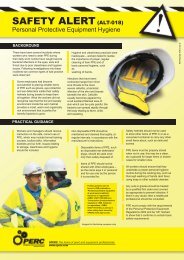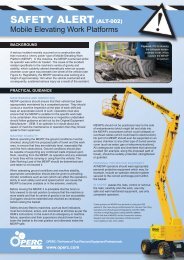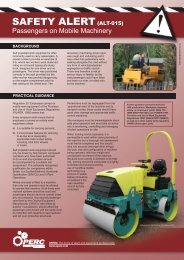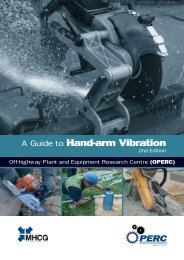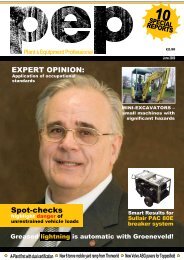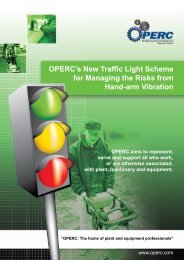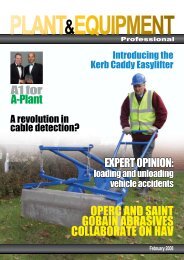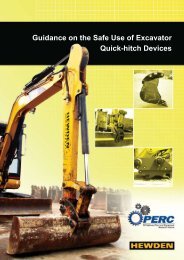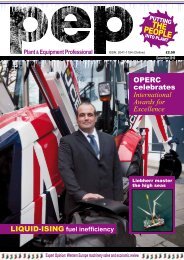the PeoPle - OPERC - Off-highway Plant and Equipment Research ...
the PeoPle - OPERC - Off-highway Plant and Equipment Research ...
the PeoPle - OPERC - Off-highway Plant and Equipment Research ...
Create successful ePaper yourself
Turn your PDF publications into a flip-book with our unique Google optimized e-Paper software.
SPECIAL REPORT<br />
introduction<br />
The excavator, or more<br />
specifically its excavating<br />
arm <strong>and</strong> array of possible<br />
attachments, is well<br />
recognised for its multitude<br />
of practical uses. This<br />
applies to, for instance,<br />
<strong>the</strong> tracked excavator, its<br />
rubber wheeled cousin<br />
<strong>and</strong> <strong>the</strong> dipper arm of<br />
a backhoe loader.<br />
In addition to excavating,<br />
<strong>the</strong> arm <strong>and</strong> chosen<br />
attachment might be used<br />
for a variety of tasks such<br />
as loading or moving<br />
spoil; grading or levelling;<br />
pushing, pulling or o<strong>the</strong>rwise<br />
moving heavy objects along<br />
<strong>the</strong> ground; breaking out<br />
hard materials <strong>and</strong> so on.<br />
Ano<strong>the</strong>r popular application<br />
is to use <strong>the</strong> arm to lift,<br />
move <strong>and</strong> place materials<br />
or components – what we<br />
will term here as ‘using an<br />
excavator as a crane’.<br />
However, <strong>the</strong>re is a big<br />
difference between <strong>the</strong><br />
former ‘more general’ uses<br />
18<br />
August 2010<br />
<strong>and</strong> <strong>the</strong> latter – a difference<br />
which exposes <strong>the</strong> machine<br />
<strong>and</strong> its owner to important<br />
relevant lifting legislation<br />
<strong>and</strong> brings with it additional<br />
significant hazards. We<br />
will consider <strong>the</strong>se issues<br />
of legislation <strong>and</strong> hazards<br />
relating to using excavators<br />
as cranes, in turn.<br />
using an excavator<br />
as a crane – some<br />
health <strong>and</strong> safety<br />
legislation<br />
There is much health <strong>and</strong><br />
safety legislation that<br />
applies to excavator use<br />
<strong>and</strong> although this is not<br />
<strong>the</strong> focus of this article,<br />
two important items<br />
worthy of mention are The<br />
Provision <strong>and</strong> Use of Work<br />
<strong>Equipment</strong> Regulations<br />
(1998) <strong>and</strong> The Supply<br />
of Machinery (Safety)<br />
Regulations (2008). It<br />
is when an excavator<br />
is used as a crane that<br />
additional health <strong>and</strong> safety<br />
legislation takes effect (on<br />
<strong>the</strong> owner <strong>and</strong> operator);<br />
but when exactly does this<br />
excavators<br />
used as cranes<br />
additional legislation apply?<br />
International St<strong>and</strong>ard EN<br />
474-1: 2006, identifies that<br />
<strong>the</strong> critical point at which an<br />
excavator is considered as<br />
being ‘used as a crane’ is<br />
when it commences ‘object<br />
h<strong>and</strong>ling’. Object h<strong>and</strong>ling,<br />
according to EN 474-1 is<br />
application of <strong>the</strong> excavator<br />
to, “...lifting, lowering <strong>and</strong><br />
transporting of a load by<br />
use of lifting accessories,<br />
whereby <strong>the</strong> assistance of<br />
a person or <strong>the</strong> operator<br />
of <strong>the</strong> machine is required<br />
for hooking, unhooking,<br />
or stabilising (while<br />
transporting) <strong>the</strong> load”. A<br />
typical ‘load’ in this instance<br />
might be a pipe that is lifted<br />
for placing into a trench<br />
that <strong>the</strong> excavator has just<br />
prepared. Lifting accessories<br />
includes things like chains,<br />
straps <strong>and</strong> shackles.<br />
O<strong>the</strong>r excavator functions<br />
identified in <strong>the</strong> st<strong>and</strong>ard<br />
such as “...excavating,<br />
loading, transporting,<br />
spreading, compacting or<br />
trenching of earth, rock<br />
“everyone’s talking about it!”<br />
Article by Gary Holt BSc(Hons), PhD,<br />
FCIOB, Loughborough University’<br />
or similar materials” are<br />
considered ‘earth moving’<br />
operations <strong>and</strong> not <strong>the</strong>refore<br />
prone to this additional lifting<br />
legislation. To avoid any<br />
confusion here, generally, if<br />
an excavator picks up a load<br />
in its bucket (or grab etc.)<br />
without <strong>the</strong> added assistance<br />
of a person for hooking,<br />
stabilising or unhooking<br />
it, <strong>the</strong>n this is not deemed<br />
to be object h<strong>and</strong>ling.<br />
When being used for<br />
object h<strong>and</strong>ling (i.e. using<br />
<strong>the</strong> excavator as a crane)<br />
excavators <strong>and</strong> <strong>the</strong>ir lifting<br />
accessories are subject<br />
to <strong>the</strong> requirements of<br />
<strong>the</strong> Lifting Operations<br />
<strong>and</strong> Lifting <strong>Equipment</strong><br />
Regulations 1998 (‘LOLER’).<br />
Broadly summarised,<br />
LOLER requires that lifting<br />
equipment is: strong enough<br />
for <strong>the</strong> intended use; marked<br />
to indicate safe working<br />
loads (SWLs): used safely<br />
such that <strong>the</strong> intended lifting<br />
is planned <strong>and</strong> performed<br />
by competent workers; <strong>and</strong><br />
subjected to an ongoing<br />
inspection regime.



